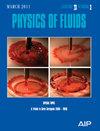关于微尺度后向台阶气蚀流的新见解
IF 4.1
2区 工程技术
Q1 MECHANICS
引用次数: 0
摘要
本研究首次对微尺度后向阶梯(BFS)结构中的剪切空化进行了实验分析。它探讨了在深度为 60 μm、阶梯高度为 400 μm 的微流体设备中各种流动条件下的剪切层空化。BFS 配置具有上游湍流和吸附后压力恢复的独特特性,为研究剪切力诱发的空化提供了受控环境,而不像其他微流体几何结构那样复杂。通过改变上游压力和雷诺数,对四种流动模式进行了实验:开始、发展、脱落和强烈脱落。该研究强调了微尺度剪切空化与大尺度剪切空化之间的主要区别,如表面力对核分布、蒸汽形成的主导作用,以及脱落和冲击波传播等现象的不同时间尺度。假设剪切层中的涡旋强度在上游冲击波传播过程中对空穴脱落起着重要作用。结果表明,压力的增加会显著提高剪切层的平均厚度、长度和强度。瞬时数据分析确定了重新附着区的两种涡旋模式(脱落模式和唤醒模式),它们对空化脱落频率和下游穿透力有显著影响。唤醒模式的特点是涡流更强、频率更低,与脱落模式相比,唤醒模式能将空穴输送到通道更深处。此外,涡流强度与雷诺数成正比,会影响冲击波引起的凝结。研究证实,在空化萌发过程中,晶核浓度在剪切层的后半部达到峰值,与空隙率峰值区域一致。本文章由计算机程序翻译,如有差异,请以英文原文为准。
New insights on cavitating flows over a microscale backward-facing step
This study introduces the first experimental analysis of shear cavitation in a microscale backward-facing step (BFS) configuration. It explores shear layer cavitation under various flow conditions in a microfluidic device with a depth of 60 μm and a step height of 400 μm. The BFS configuration, with its unique characteristics of upstream turbulence and post-reattachment pressure recovery, provides a controlled environment for studying shear-induced cavitation without the complexities of other microfluidic geometries. Experiments were conducted across four flow patterns: inception, developing, shedding, and intense shedding, by varying upstream pressure and the Reynolds number. The study highlights key differences between microscale and macroscale shear cavitation, such as the dominant role of surface forces on nuclei distribution, vapor formation, and distinct timescales for phenomena like shedding and shockwave propagation. It is hypothesized that vortex strength in the shear layer plays a significant role in cavity shedding during upstream shockwave propagation. Results indicate that increased pressure notably elevates the mean thickness, length, and intensity within the shear layer. Instantaneous data analysis identified two vortex modes (shedding and wake modes) at the reattachment zone, which significantly affect cavitation shedding frequency and downstream penetration. The wake mode, characterized by stronger and lower-frequency vortices, transports cavities deeper into the channel compared to the shedding mode. Additionally, vortex strength, proportional to the Reynolds number, affects condensation caused by shockwaves. The study confirms that nuclei concentration peaks in the latter half of the shear layer during cavitation inception, aligning with the peak void fraction region.
求助全文
通过发布文献求助,成功后即可免费获取论文全文。
去求助
来源期刊

Physics of Fluids
物理-力学
CiteScore
6.50
自引率
41.30%
发文量
2063
审稿时长
2.6 months
期刊介绍:
Physics of Fluids (PoF) is a preeminent journal devoted to publishing original theoretical, computational, and experimental contributions to the understanding of the dynamics of gases, liquids, and complex or multiphase fluids. Topics published in PoF are diverse and reflect the most important subjects in fluid dynamics, including, but not limited to:
-Acoustics
-Aerospace and aeronautical flow
-Astrophysical flow
-Biofluid mechanics
-Cavitation and cavitating flows
-Combustion flows
-Complex fluids
-Compressible flow
-Computational fluid dynamics
-Contact lines
-Continuum mechanics
-Convection
-Cryogenic flow
-Droplets
-Electrical and magnetic effects in fluid flow
-Foam, bubble, and film mechanics
-Flow control
-Flow instability and transition
-Flow orientation and anisotropy
-Flows with other transport phenomena
-Flows with complex boundary conditions
-Flow visualization
-Fluid mechanics
-Fluid physical properties
-Fluid–structure interactions
-Free surface flows
-Geophysical flow
-Interfacial flow
-Knudsen flow
-Laminar flow
-Liquid crystals
-Mathematics of fluids
-Micro- and nanofluid mechanics
-Mixing
-Molecular theory
-Nanofluidics
-Particulate, multiphase, and granular flow
-Processing flows
-Relativistic fluid mechanics
-Rotating flows
-Shock wave phenomena
-Soft matter
-Stratified flows
-Supercritical fluids
-Superfluidity
-Thermodynamics of flow systems
-Transonic flow
-Turbulent flow
-Viscous and non-Newtonian flow
-Viscoelasticity
-Vortex dynamics
-Waves
 求助内容:
求助内容: 应助结果提醒方式:
应助结果提醒方式:


